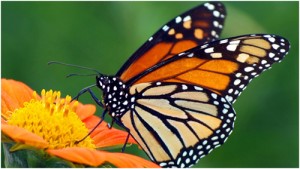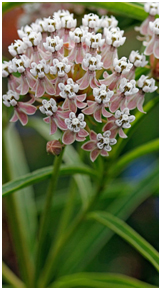Save the Monarchs
 The iconic monarch butterfly is famous the world over for its amazing migration from the US and Canada to mountain forests in Mexico to overwinter. Other populations on the west coast migrate to Southern California. There is a problem with the monarchs. The populations have dwindled by as much as 90% in the past few years. The reasons are loss of habitat, logging in the mountain forests in Mexico, and the use of herbicides that have reduced the population of this butterfly’s host plant, milkweed. In March of 2015, USFWS began a yearlong review to consider listing the monarch as threatened under the Endangered Species Act. In the meantime, an agreement between the US, Canada, and Mexico has been made to improve conditions for this butterfly.
The iconic monarch butterfly is famous the world over for its amazing migration from the US and Canada to mountain forests in Mexico to overwinter. Other populations on the west coast migrate to Southern California. There is a problem with the monarchs. The populations have dwindled by as much as 90% in the past few years. The reasons are loss of habitat, logging in the mountain forests in Mexico, and the use of herbicides that have reduced the population of this butterfly’s host plant, milkweed. In March of 2015, USFWS began a yearlong review to consider listing the monarch as threatened under the Endangered Species Act. In the meantime, an agreement between the US, Canada, and Mexico has been made to improve conditions for this butterfly.
Dr. David James of WSU has become involved with monarch recovery efforts. For example, he is working with inmates at the Walla Walla State Prison to rear Monarch butterflies, tag them, and release them. The tags have the e-mail address for WSU so information can be gained about west coast monarch migration patterns. There is even a Facebook page for sharing information about Monarchs and Monarch sightings: https://www.facebook.com/MonarchButterfliesInThePacificNorthwest.
Dr. James responded to an e-mail about growing milkweeds in Ridgefield to provide habitat for Monarchs. His response: ”I see no problem with what you are planning to do! Although milkweeds may not naturally occur in your area they certainly can survive there and will provide resources for any monarchs that come through as they did this year. We had a number of sightings in the Portland/Vancouver areas including instances of monarchs laying eggs and developing on backyard milkweeds! A number of people in Portland told me they had been growing milkweed to attract monarchs to their gardens for years and this was the first time they had showed up! I anticipate as the overall monarch population grows (as hopefully it will), there’ll be more sightings on the Washington coast especially if the climate warms further. So I think establishing milkweed in back yards in your area is definitely a worthwhile thing to do. Another benefit of milkweed is that it attracts pollinators and other beneficial insects! In recent research we ranked it in the top 10 (out of ~ 120) native plants in the number of beneficial insects it attracted. So good luck with your efforts!”
We are encouraged to grow milkweed plants in garden spaces in Ridgefield. It is best to have species that are native to our area. There are no native milkweed plants in Clark County, however, there are two species that grow in the Willamette valley and in the Columbia River Gorge. These species are the narrow leaved milkweed and the showy milkweed. In July I went to the gorge and was able to get several hundred seedpods of the narrow leaved milkweed. I was not able to get any of the showy milkweeds. There are nurseries and seed suppliers that can provide both plants and seeds for many other species of milkweed. They have a perennial underground rhizome and a single plant will send up shoots making new plants. They are drought and deer resistant. It was 100 degrees in the gorge in July and most other plants were dead and brown. The milkweeds were green and in full bloom. In flower, the plants are very pretty and would complement any flower garden.
I have made 38 packages of milkweed seeds to give away. The seeds are in sterile sand in Ziploc bags. The packages are available from Tammy Claflin at Ridgefield Floral, 328 Pioneer Street, and Scott and Cathy Hughes at Ridgefield Hardware, Main and Pioneer. Although they can be sown outdoors, germination is better in seed starter containers under bright lights or in a greenhouse. A set of instructions comes with each bag as the seeds need to be kept in a refrigerator for a period of time.

